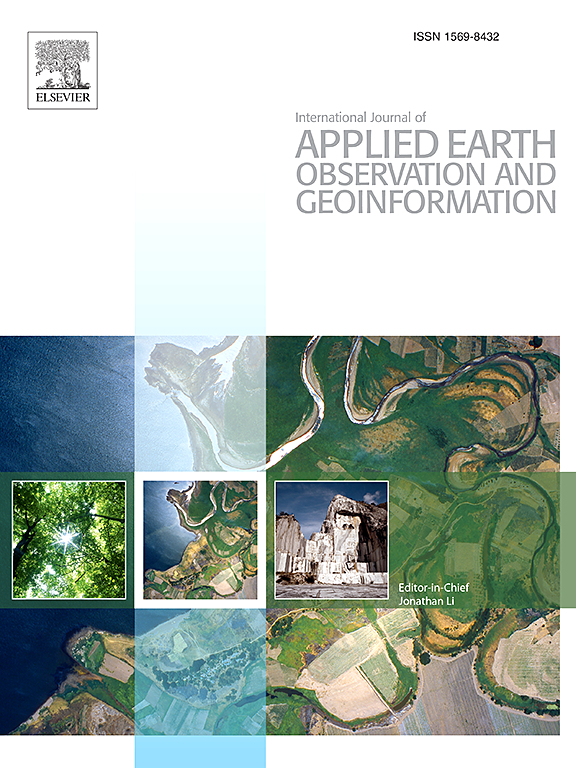通过分层深度不平衡回归预测作物产量的高低:以葡萄园为例
IF 7.6
Q1 REMOTE SENSING
International journal of applied earth observation and geoinformation : ITC journal
Pub Date : 2025-04-25
DOI:10.1016/j.jag.2025.104536
引用次数: 0
摘要
作物产量估计对农业管理至关重要,但往往难以预测可能对经营和市场产生重大影响的极端值。传统模型面临这些极端情况的挑战,导致有偏见和不准确的预测。为了应对这一挑战,我们的研究引入了两种创新策略。首先,我们提出了一个成本敏感的损失函数,ExtremeLoss,旨在通过在训练过程中给予极端情况更大的重要性来更好地捕获和表示不太频繁的yield值。其次,我们开发了一个条件深度学习模型,该模型通过对分类产量观察图进行条件反射来增强特征表示。这种方法通过利用产量桶内部和桶之间的相似性,鼓励在产量值范围的不同部分之间建立更平滑、更连贯的输入特征图,最终提高模型概括和区分产量细微变化的能力。这种方法创建了“产量区图”,将产量分组(例如,低极值、普通极值、高极值),以提高对产量可变性的识别,这可以在推理过程中删除。我们的模型在2016年至2019年的综合葡萄产量数据集上进行了测试,该数据集涵盖2200公顷和8个品种的42个区块。我们在两种验证场景下将其性能与先进的技术(如Focal-R loss,标签分布平滑,密集加权和类平衡方法)进行了比较:块保持(BHO)和年块保持(YBHO)。我们的方法在r平方(R2)、平均绝对误差(MAE)、均方根误差(RMSE)和平均绝对百分比误差(MAPE)方面优于现有模型。值得注意的是,在BHO情景中,低极端和高极端的MAE分别降低了+2.98和+14.45 (t/ha),在YBHO情景中,MAE分别降低了+7.18和+11.05 (t/ha)。在BHO情景下,MAPE分别显著降低+19.09%和+23.94%,在YBHO情景下,MAPE分别降低+33.76%和+19.61%。我们的模型在捕获空间变异性方面有了显著的改进,在时空产量估算方面也有了显著的进步,特别是在葡萄园等复杂农业环境中的极端值方面。本文章由计算机程序翻译,如有差异,请以英文原文为准。
Predicting crop yield lows through the highs via binned deep imbalanced regression: A case study on vineyards
Crop yield estimation is vital for agricultural management but often struggles with predicting extreme values that can significantly impact operations and markets. Traditional models face challenges with these extremes, leading to biased and inaccurate predictions. To address this challenge, our study introduces two innovative strategies. First, we propose a cost-sensitive loss function, ExtremeLoss, designed to better capture and represent less frequent yield values by giving greater importance to extreme cases during training. Second, we develop a conditional deep learning model that enhances feature representation by conditioning on a binned yield observation map. This approach encourages smoother and more coherent input feature maps across different segments of the yield value range by leveraging similarities within and across yield bins, ultimately improving the model’s ability to generalize and distinguish between subtle variations in yield. This approach creates ”yield zone maps,” grouping yields into classes (e.g., low extreme, common, high extreme) to improve the identification of yield variability, which can be removed during inference. Our model was tested on a comprehensive grape yield dataset from 2016 to 2019, covering 2,200 hectares and 42 blocks of eight cultivars. We compared its performance against advanced techniques such as Focal-R loss, label distribution smoothing, dense weighting, and class-balanced methods under two validation scenarios: block-hold-out (BHO) and year-block-hold-out (YBHO). Our approach outperforms existing models in R-squared , Mean Absolute Error (MAE), Root Mean Squared Error (RMSE), and Mean Absolute Percentage Error (MAPE). Notably, it reduces MAE by +2.98 and +14.45 (t/ha) for low and high extremes in the BHO scenario and by +7.18 and +11.05 (t/ha) in the YBHO scenario. It also significantly decreases MAPE by +19.09% and +23.94% in the BHO scenario and by +33.76% and +19.61% in the YBHO scenario. Our model shows a marked improvement in capturing spatial variability and significantly advances spatio-temporal yield estimation, particularly for extreme values in complex agricultural settings like vineyards.
求助全文
通过发布文献求助,成功后即可免费获取论文全文。
去求助
来源期刊

International journal of applied earth observation and geoinformation : ITC journal
Global and Planetary Change, Management, Monitoring, Policy and Law, Earth-Surface Processes, Computers in Earth Sciences
CiteScore
12.00
自引率
0.00%
发文量
0
审稿时长
77 days
期刊介绍:
The International Journal of Applied Earth Observation and Geoinformation publishes original papers that utilize earth observation data for natural resource and environmental inventory and management. These data primarily originate from remote sensing platforms, including satellites and aircraft, supplemented by surface and subsurface measurements. Addressing natural resources such as forests, agricultural land, soils, and water, as well as environmental concerns like biodiversity, land degradation, and hazards, the journal explores conceptual and data-driven approaches. It covers geoinformation themes like capturing, databasing, visualization, interpretation, data quality, and spatial uncertainty.
 求助内容:
求助内容: 应助结果提醒方式:
应助结果提醒方式:


